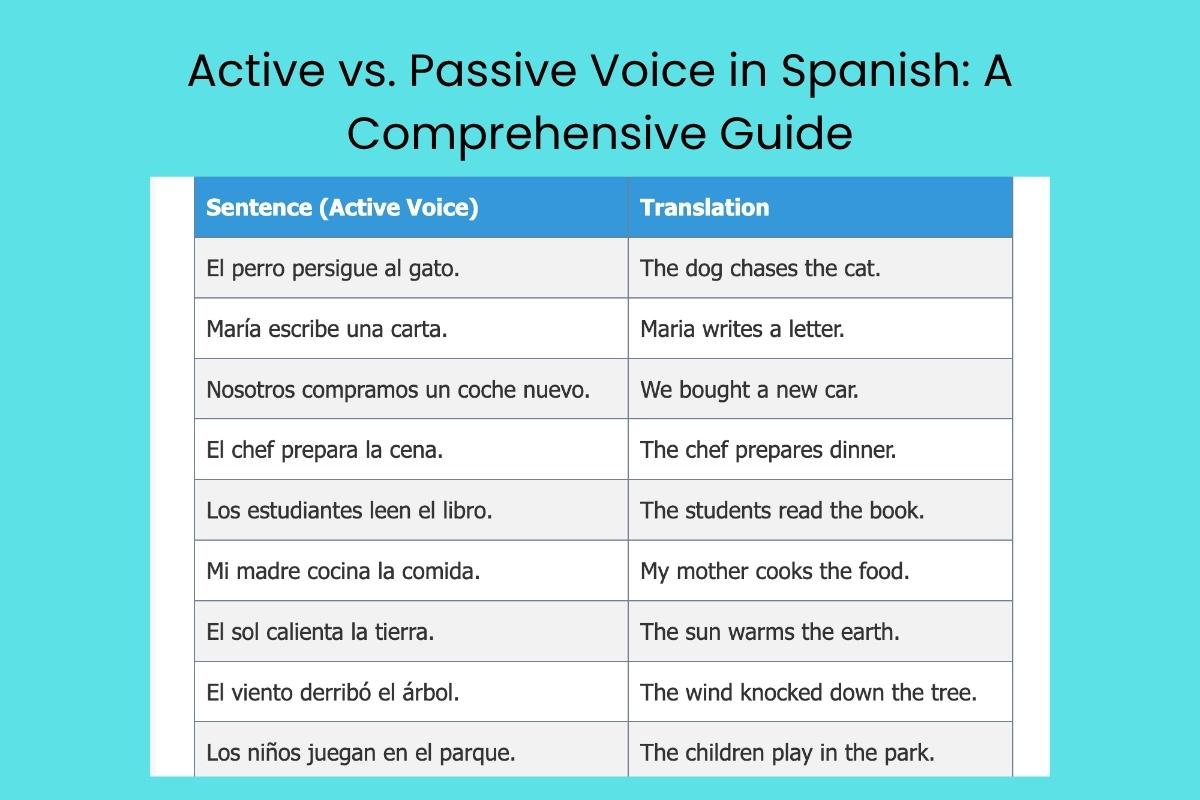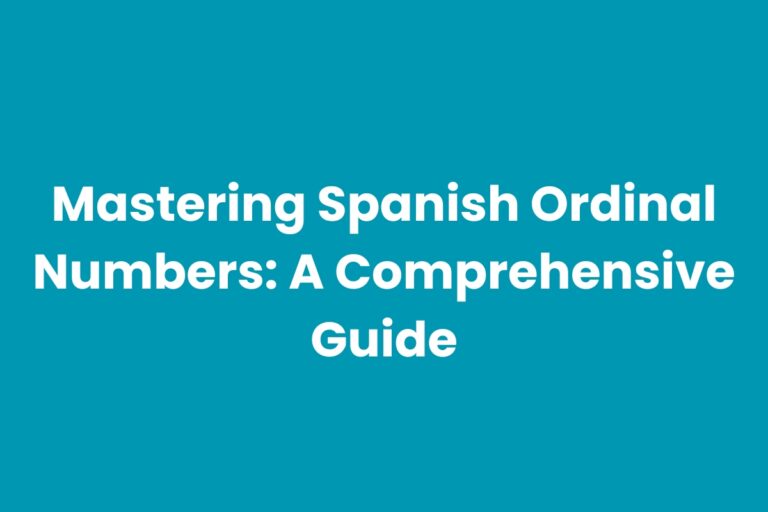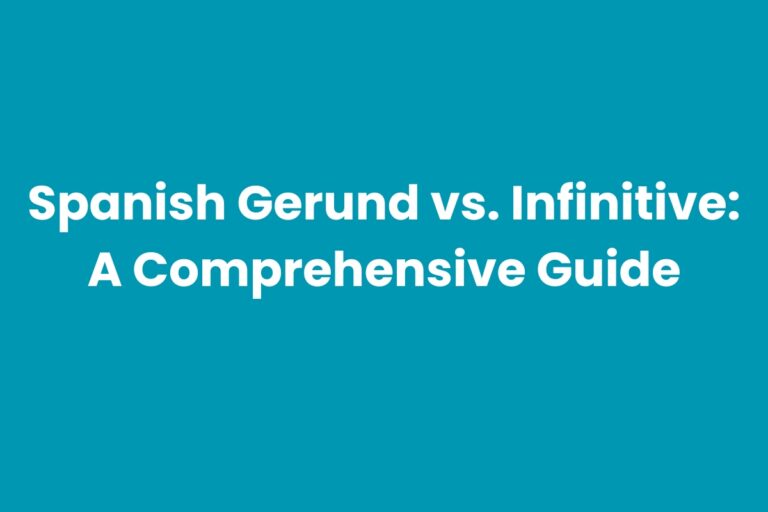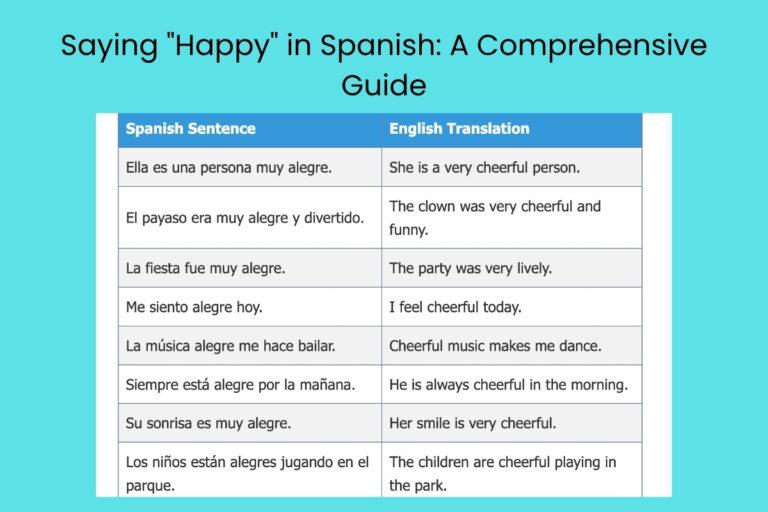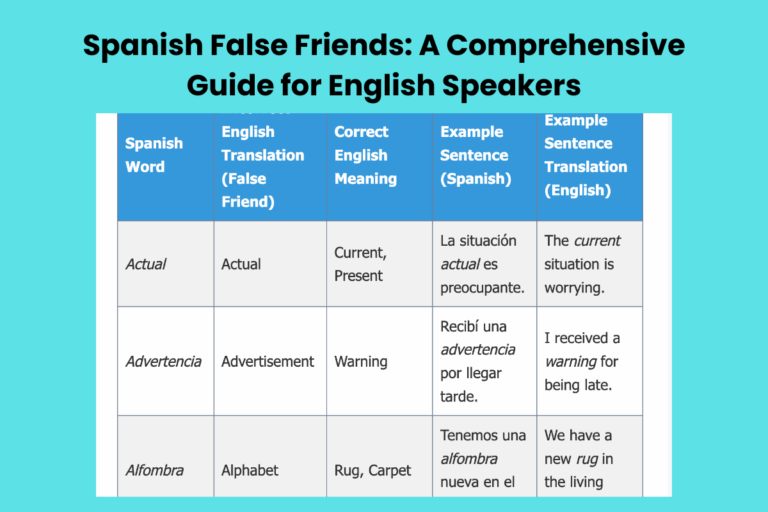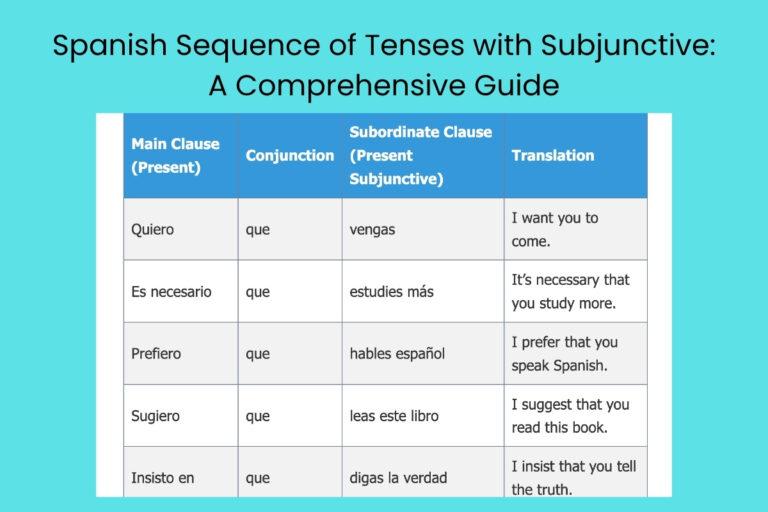Active vs. Passive Voice in Spanish: A Comprehensive Guide
Understanding the active and passive voice is crucial for mastering Spanish grammar. This knowledge allows you to construct sentences with clarity and precision, emphasizing either the subject performing the action (active voice) or the object receiving the action (passive voice).
This article provides a comprehensive guide, covering definitions, structures, examples, usage rules, common mistakes, and practice exercises to help you confidently navigate these grammatical concepts. Whether you are a beginner or an advanced learner, this resource will enhance your ability to express yourself effectively in Spanish.
Table of Contents
- Introduction
- Definition of Active and Passive Voice
- Structural Breakdown
- Types and Categories of Passive Voice
- Examples
- Usage Rules
- Common Mistakes
- Practice Exercises
- Advanced Topics
- FAQ
- Conclusion
Definition of Active and Passive Voice
The voice of a verb indicates whether the subject performs the action (active voice) or receives the action (passive voice. Understanding the difference between active and passive voice is crucial for clear and effective communication in Spanish.
Active Voice
In the active voice, the subject performs the action expressed by the verb. The focus is on who or what is doing the action. Active voice constructions are typically more direct and concise. It is the more common and natural way to express ideas in both spoken and written Spanish.
Passive Voice
In the passive voice, the subject receives the action expressed by the verb. The focus shifts from the actor to the recipient of the action. The passive voice is formed using a form of the verb ser (to be) followed by the past participle of the main verb. Sometimes, the agent performing the action is introduced by the preposition por (by).
Structural Breakdown
The structure of active and passive sentences differs significantly. Understanding these structures is key to correctly forming and interpreting sentences in each voice.
Active Voice Structure
The basic structure of an active voice sentence in Spanish is: Subject + Verb + (Object). The object is optional, depending on whether the verb is transitive (takes an object) or intransitive (does not take an object).
For example, in the sentence “Juan come manzanas” (Juan eats apples), Juan is the subject, come is the verb, and manzanas is the object.
Passive Voice Structure
The passive voice structure in Spanish is: Subject (recipient of the action) + Ser + Past Participle + (Por + Agent). The agent (the one performing the action) is often omitted, especially when it’s unknown or unimportant. The past participle must agree in gender and number with the subject.
For example, in the sentence “Las manzanas son comidas por Juan” (The apples are eaten by Juan), las manzanas is the subject (recipient), son comidas is the verb (ser + past participle), and por Juan indicates the agent.
Types and Categories of Passive Voice
Spanish has two main ways to express the passive voice: using the verb ser and using the reflexive pronoun se.
Passive with Ser
This is the standard form of the passive voice, similar to the English passive voice. It is formed using a conjugated form of the verb ser (to be) followed by the past participle of the main verb. The past participle must agree in gender and number with the subject of the sentence.
Example: “El libro fue escrito por Gabriel García Márquez.” (The book was written by Gabriel García Márquez.)
Reflexive Passive (Se Passive)
The reflexive passive, also known as the se passive, is used when the agent performing the action is not specified or is unimportant. It is formed using the reflexive pronoun se followed by a transitive verb in the third person singular or plural. The verb agrees in number with the noun that follows it.
Example: “Se venden casas aquí.” (Houses are sold here.)
Examples
This section provides numerous examples of active and passive voice in Spanish, illustrating the different forms and uses.
Active Voice Examples
The following table provides examples of sentences in the active voice, showcasing how the subject performs the action.
| Sentence (Active Voice) | Translation |
|---|---|
| El perro persigue al gato. | The dog chases the cat. |
| María escribe una carta. | Maria writes a letter. |
| Nosotros compramos un coche nuevo. | We bought a new car. |
| El chef prepara la cena. | The chef prepares dinner. |
| Los estudiantes leen el libro. | The students read the book. |
| Mi madre cocina la comida. | My mother cooks the food. |
| El sol calienta la tierra. | The sun warms the earth. |
| El viento derribó el árbol. | The wind knocked down the tree. |
| Los niños juegan en el parque. | The children play in the park. |
| La lluvia moja las calles. | The rain wets the streets. |
| El profesor explica la lección. | The teacher explains the lesson. |
| Ella canta una canción. | She sings a song. |
| Yo bebo agua. | I drink water. |
| Tú hablas español. | You speak Spanish. |
| Él conduce un coche. | He drives a car. |
| Nosotros vivimos en Madrid. | We live in Madrid. |
| Vosotros coméis pizza. | You (plural) eat pizza. |
| Ellos ven la televisión. | They watch television. |
| El gato duerme en el sofá. | The cat sleeps on the sofa. |
| El pájaro vuela en el cielo. | The bird flies in the sky. |
| Mi hermano lava los platos. | My brother washes the dishes. |
| El cartero entrega el correo. | The mailman delivers the mail. |
| El jardinero corta el césped. | The gardener cuts the grass. |
| El mecánico arregla el coche. | The mechanic fixes the car. |
| El panadero hornea el pan. | The baker bakes the bread. |
| El electricista instala las luces. | The electrician installs the lights. |
| El fontanero repara la tubería. | The plumber repairs the pipe. |
| El carpintero construye la casa. | The carpenter builds the house. |
| El pintor pinta la pared. | The painter paints the wall. |
The table above provides a clear illustration of the active voice, where the subject performs the action. Each example demonstrates the basic structure of subject + verb + (object).
Passive with Ser Examples
The following table provides examples of the passive voice using ser, highlighting how the subject receives the action.
| Sentence (Passive with Ser) | Translation |
|---|---|
| La carta fue escrita por María. | The letter was written by Maria. |
| El coche nuevo fue comprado por nosotros. | The new car was bought by us. |
| La cena es preparada por el chef. | Dinner is prepared by the chef. |
| El libro es leído por los estudiantes. | The book is read by the students. |
| La comida es cocinada por mi madre. | The food is cooked by my mother. |
| La tierra es calentada por el sol. | The earth is warmed by the sun. |
| El árbol fue derribado por el viento. | The tree was knocked down by the wind. |
| Las calles son mojadas por la lluvia. | The streets are wet by the rain. |
| La lección es explicada por el profesor. | The lesson is explained by the teacher. |
| Una canción es cantada por ella. | A song is sung by her. |
| El agua es bebida por mí. | The water is drunk by me. |
| El español es hablado por ti. | Spanish is spoken by you. |
| Un coche es conducido por él. | A car is driven by him. |
| Madrid es vivido por nosotros. | Madrid is lived in by us. |
| La pizza es comida por vosotros. | Pizza is eaten by you (plural). |
| La televisión es vista por ellos. | Television is watched by them. |
| El café es bebido por Juan. | The coffee is drunk by Juan. |
| La puerta fue cerrada por el viento. | The door was closed by the wind. |
| La ventana es abierta por María. | The window is opened by Maria. |
| Los platos son lavados por mi hermano. | The dishes are washed by my brother. |
| El correo es entregado por el cartero. | The mail is delivered by the mailman. |
| El césped es cortado por el jardinero. | The grass is cut by the gardener. |
| El coche es arreglado por el mecánico. | The car is fixed by the mechanic. |
| El pan es horneado por el panadero. | The bread is baked by the baker. |
| Las luces son instaladas por el electricista. | The lights are installed by the electrician. |
| La tubería es reparada por el fontanero. | The pipe is repaired by the plumber. |
| La casa es construida por el carpintero. | The house is built by the carpenter. |
| La pared es pintada por el pintor. | The wall is painted by the painter. |
| El pastel fue comido por los niños. | The cake was eaten by the children. |
This table illustrates the passive voice using the verb ser. Notice how the past participle agrees in gender and number with the subject. The agent performing the action is introduced by por.
Reflexive Passive (Se Passive) Examples
The following table provides examples of the reflexive passive, where the agent is not specified or is unimportant.
| Sentence (Se Passive) | Translation |
|---|---|
| Se venden casas. | Houses are sold. |
| Se alquilan apartamentos. | Apartments are rented. |
| Se habla español aquí. | Spanish is spoken here. |
| Se necesitan empleados. | Employees are needed. |
| Se busca camarero. | Waiter is wanted. |
| Se prohíbe fumar. | Smoking is prohibited. |
| Se construyen edificios nuevos. | New buildings are being built. |
| Se reparan coches. | Cars are repaired. |
| Se ofrecen clases de inglés. | English classes are offered. |
| Se aceptan tarjetas de crédito. | Credit cards are accepted. |
| Se come bien en este restaurante. | One eats well in this restaurant. (Good food is eaten) |
| Se vive bien en esta ciudad. | One lives well in this city. (Life is good) |
| Se dice que va a llover. | It is said that it is going to rain. |
| Se cree que es inocente. | It is believed that he is innocent. |
| Se rumorea que se van a casar. | It is rumored that they are going to get married. |
| Se espera que llegue pronto. | It is expected that he will arrive soon. |
| Se sabe que es un buen profesor. | It is known that he is a good teacher. |
| Se teme que haya problemas. | It is feared that there will be problems. |
| Se ven muchas estrellas esta noche. | Many stars are seen tonight. |
| Se oyen ruidos extraños. | Strange noises are heard. |
| Se fabrican juguetes aquí. | Toys are manufactured here. |
| Se imprimen libros en esta imprenta. | Books are printed in this printing press. |
| Se cultivan flores en este jardín. | Flowers are grown in this garden. |
| Se crían animales en esta granja. | Animals are raised on this farm. |
| Se organizan fiestas todos los fines de semana. | Parties are organized every weekend. |
| Se publican noticias en este periódico. | News is published in this newspaper. |
| Se venden entradas para el concierto. | Tickets are sold for the concert. |
| Se necesitan voluntarios para el evento. | Volunteers are needed for the event. |
This table demonstrates the se passive, where the focus is on the action rather than the actor. The verb agrees in number with the noun that follows se.
Active to Passive Transformations
The following table illustrates how active voice sentences can be transformed into passive voice sentences using both ser and se.
| Active Voice | Passive with Ser | Se Passive |
|---|---|---|
| El perro come la carne. | La carne es comida por el perro. | Se come la carne. |
| Juan escribe el libro. | El libro es escrito por Juan. | Se escribe el libro. |
| Ellos construyen la casa. | La casa es construida por ellos. | Se construye la casa. |
| Nosotros vendemos los coches. | Los coches son vendidos por nosotros. | Se venden los coches. |
| El chef prepara la comida. | La comida es preparada por el chef. | Se prepara la comida. |
| El profesor explica la lección. | La lección es explicada por el profesor. | Se explica la lección. |
| Maria lee el periódico. | El periódico es leído por Maria. | Se lee el periódico. |
| El cartero entrega las cartas. | Las cartas son entregadas por el cartero. | Se entregan las cartas. |
| El fontanero repara la tubería. | La tubería es reparada por el fontanero. | Se repara la tubería. |
| El jardinero corta el césped. | El césped es cortado por el jardinero. | Se corta el césped. |
| El electricista instala las luces. | Las luces son instaladas por el electricista. | Se instalan las luces. |
| El panadero hornea el pan. | El pan es horneado por el panadero. | Se hornea el pan. |
| Los estudiantes aprenden la lección. | La lección es aprendida por los estudiantes. | Se aprende la lección. |
| El público aplaude al artista. | El artista es aplaudido por el público. | Se aplaude al artista. |
| La policía arresta al ladrón. | El ladrón es arrestado por la policía. | Se arresta al ladrón. |
| El juez condena al criminal. | El criminal es condenado por el juez. | Se condena al criminal. |
| El médico cura al paciente. | El paciente es curado por el médico. | Se cura al paciente. |
| El dentista extrae el diente. | El diente es extraído por el dentista. | Se extrae el diente. |
| El profesor corrige los exámenes. | Los exámenes son corregidos por el profesor. | Se corrigen los exámenes. |
| La empresa contrata empleados. | Empleados son contratados por la empresa. | Se contratan empleados. |
This table provides a direct comparison of active and passive voice constructions, demonstrating how a single idea can be expressed in different ways depending on the desired emphasis.
Usage Rules
Understanding the specific rules for using the passive voice is essential for avoiding errors and ensuring clarity in your Spanish writing and speech.
Usage Rules for Ser Passive
- Agreement: The past participle must agree in gender and number with the subject of the sentence.
- Agent: The agent performing the action is introduced by the preposition por. However, the agent can be omitted if it is unknown, unimportant, or obvious.
- Tense: The verb ser is conjugated in the tense that corresponds to the active voice sentence. For example, if the active sentence is in the present tense, ser will be in the present tense.
Usage Rules for Se Passive
- Transitive Verb: The se passive is only used with transitive verbs (verbs that take a direct object).
- Third Person: The verb must be in the third person singular or plural.
- Agreement: The verb agrees in number with the noun that follows se. If the noun is singular, the verb is singular; if the noun is plural, the verb is plural.
- No Agent: The se passive is used when the agent performing the action is not specified or is unimportant.
When to Use Passive Voice
The passive voice is useful in the following situations:
- When the agent performing the action is unknown or unimportant.
- When you want to emphasize the recipient of the action rather than the actor.
- In formal or technical writing, where objectivity is important.
When to Avoid Passive Voice
While the passive voice has its uses, it should be avoided in the following situations:
- When the active voice is more direct and concise.
- When the agent performing the action is important and should be identified.
- When overuse of the passive voice makes your writing sound awkward or unclear.
Common Mistakes
Learners often make mistakes when using the active and passive voice in Spanish. Understanding these common errors can help you improve your accuracy.
| Incorrect | Correct | Explanation |
|---|---|---|
| La carta fue escrito por María. | La carta fue escrita por María. | The past participle escrito must agree in gender with the subject la carta. |
| Se habla español. (when referring to a specific person) | Se habla español aquí. | When referring to speaking Spanish in general, “aquí” is needed to remove agency and denote a place. |
| Se vende casa. | Se vende una casa. / Se venden casas. | The verb must agree in number with the noun. If you mean “a house,” use singular; if you mean “houses,” use plural. |
| El libro fue escribir por Juan. | El libro fue escrito por Juan. | Use the past participle (escrito) instead of the infinitive (escribir). |
| Se necesita voluntarios. | Se necesitan voluntarios. | The verb (necesitan) must agree in number with the noun (voluntarios). |
This table highlights common mistakes made when using the passive voice and provides the correct alternatives with explanations.
Practice Exercises
These exercises will help you practice identifying and using the active and passive voice in Spanish.
Exercise 1: Identifying Active and Passive Voice
Identify whether the following sentences are in the active or passive voice.
| Sentence | Voice (Active/Passive) | Answer |
|---|---|---|
| El gato come el ratón. | Active/Passive | Active |
| El ratón es comido por el gato. | Active/Passive | Passive |
| Se venden libros. | Active/Passive | Passive |
| María escribe una carta. | Active/Passive | Active |
| La carta es escrita por María. | Active/Passive | Passive |
| El chef prepara la cena. | Active/Passive | Active |
| La cena es preparada por el chef. | Active/Passive | Passive |
| Se construyen casas nuevas. | Active/Passive | Passive |
| El perro persigue al cartero. | Active/Passive | Active |
| El cartero es perseguido por el perro. | Active/Passive | Passive |
Exercise 2: Transforming Active to Passive
Transform the following active voice sentences into passive voice sentences using ser.
| Active Voice | Passive Voice (with Ser) | Answer |
|---|---|---|
| Juan lee el periódico. | El periódico es leído por Juan. | |
| El profesor explica la lección. | La lección es explicada por el profesor. | |
| María lava los platos. | Los platos son lavados por María. | |
| El cartero entrega las cartas. | Las cartas son entregadas por el cartero. | |
| El viento rompió la ventana. | La ventana fue rota por el viento. | |
| El cocinero prepara la cena. | La cena es preparada por el cocinero. | |
| Los estudiantes resuelven los problemas. | Los problemas son resueltos por los estudiantes. | |
| El artista pinta el cuadro. | El cuadro es pintado por el artista. | |
| La lluvia moja la calle. | La calle es mojada por la lluvia. | |
| El sol calienta la tierra. | La tierra es calentada por el sol. |
Exercise 3: Choosing the Correct Passive Form
Complete the following sentences using the correct form of the passive voice (either ser passive or se passive).
| Sentence | Correct Passive Form | Answer |
|---|---|---|
| Aquí ______ español. (hablar) | Se habla español. | |
| La casa ______ por Juan. (construir) | La casa es construida por Juan. | |
| ______ apartamentos. (alquilar) | Se alquilan apartamentos. | |
| El libro ______ por el profesor. (recomendar) | El libro es recomendado por el profesor. | |
| ______ empleados. (necesitar) | Se necesitan empleados. | |
| La cena ______ por mi madre. (preparar) | La cena es preparada por mi madre. | |
| Aquí ______ coches. (reparar) | Se reparan coches aquí. | |
| El problema ______ por los estudiantes. (resolver) | El problema es resuelto por los estudiantes. | |
| ______ clases de baile. (ofrecer) | Se ofrecen clases de baile. | |
| La puerta ______ por el viento. (cerrar) | La puerta fue cerrada por el viento. |
Advanced Topics
For advanced learners, understanding the passive voice in more complex grammatical contexts is essential.
Passive Voice in the Subjunctive Mood
The passive voice can also be used in the subjunctive mood. This is typically used in subordinate clauses expressing doubt, desire, or possibility. The structure is similar to the indicative passive, but the verb ser is conjugated in the subjunctive.
Example: “Es importante que el libro sea leído por todos los estudiantes.” (It is important that the book be read by all the students.)
Passive Voice in Complex Tenses
The passive voice can be formed in complex tenses, such as the perfect tenses (e.g., haber + past participle). In these cases, the verb ser is replaced by haber sido.
Example: “El proyecto había sido terminado antes de la fecha límite.” (The project had been finished before the deadline.)
FAQ
Here are some frequently asked questions about the active and passive voice in Spanish.
- What is the difference between the active and passive voice?
In the active voice, the subject performs the action. In the passive voice, the subject receives the action.
- How is the passive voice formed in Spanish?
The passive voice is formed using a form of the verb ser (to be) followed by the past participle of the main verb. The past participle must agree in gender and number with the subject.
- What is the se passive?
The se passive is a form of the passive voice that uses the reflexive pronoun se followed by a transitive verb. It is used when the agent performing the action is not specified or is unimportant.
- When should I use the passive voice?
Use the passive voice when the agent performing the action is unknown or unimportant, or when you want to emphasize the recipient of the action.
- When should I avoid the passive voice?
Avoid the passive voice when the active voice is more direct and concise, or when the agent performing the action is important and should be identified.
- How do I transform an active sentence into a passive sentence?
To transform an active sentence into a passive sentence, make the object of the active sentence the subject of the passive sentence. Use a form of the verb ser followed by the past participle of the main verb. If necessary, add por + the original subject to indicate the agent.
- Does the
past participle always agree with the subject in the passive voice?
Yes, the past participle must always agree in gender and number with the subject of the passive sentence.
Conclusion
Mastering the active and passive voice in Spanish is essential for effective communication. By understanding the definitions, structures, and usage rules outlined in this guide, you can confidently construct sentences that convey your intended meaning with clarity and precision.
Whether you choose to use the active voice for its directness or the passive voice for its emphasis on the recipient of the action, your ability to navigate these grammatical concepts will significantly enhance your Spanish language skills. Keep practicing with the exercises provided, and don’t hesitate to review the common mistakes to refine your understanding.
With dedication and practice, you’ll become proficient in using both the active and passive voice in Spanish.

